Jasmine Burgan: Life on the Road in Australia
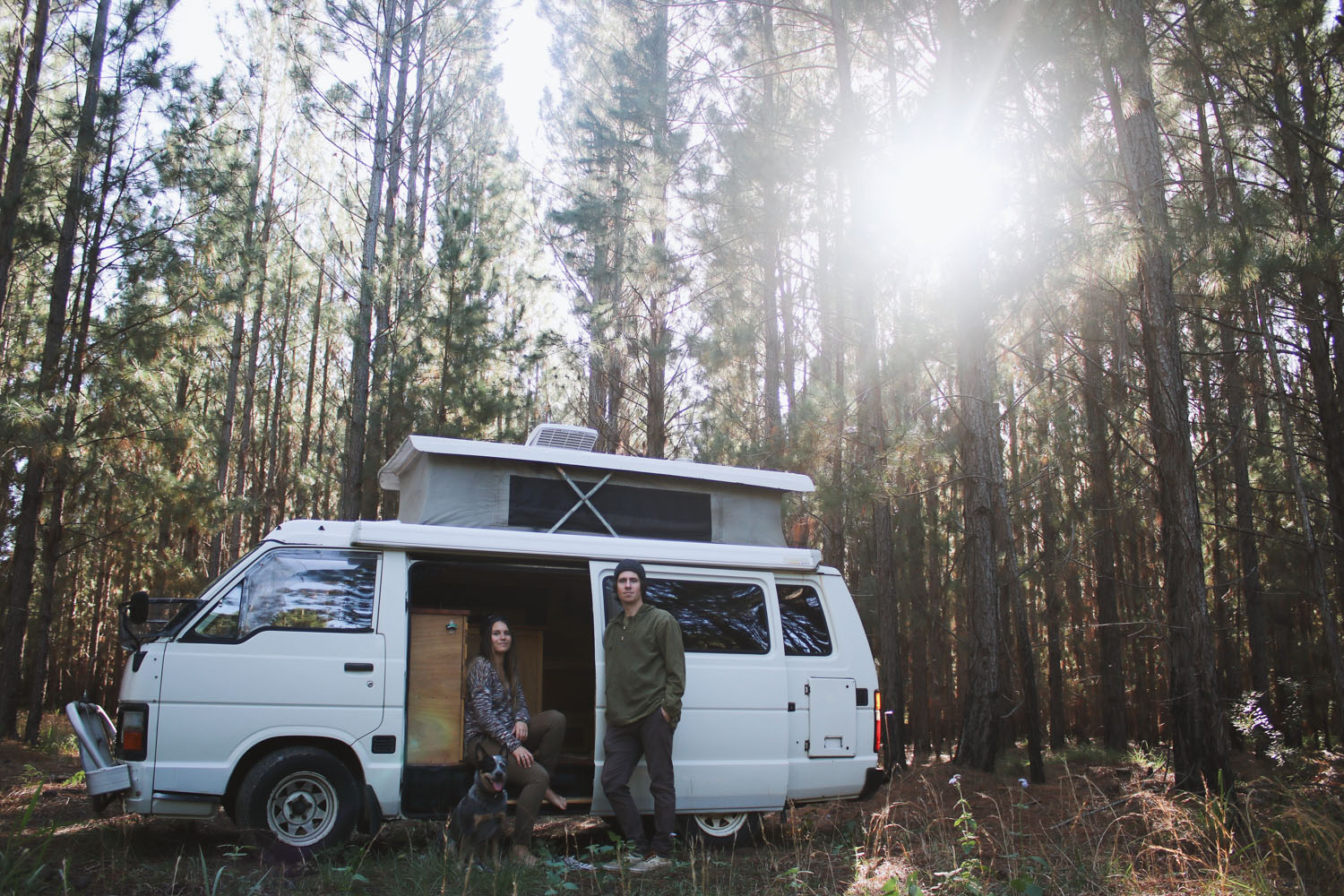
Jasmine Burgan | The Cabin Camper
Jasmine and her husband John are wildlife lovers and conservationists who advocate for minimizing plastic consumption and wastage. They’ve lived in a 1985 Toyota Hiace van for three years on the Sunshine Coast in Queensland, Australia with their dog River.
For them, living on the road is less about constant travel and more about minimalism. Condensing a life onto four wheels turned into a journey in environmental awareness.
Their lifestyle provides them with a kind of freedom that allows them to keep some roots planted too. Their Toyota is their mode of transport and Jasmine and John frequently travel outside of Australia (and sometimes they travel by van when they get where they’re going).
Learn more about Jasmine’s life on the Sunshine Coast and their war on waste. Interview below!
Meet Jasmine
How did your lifestyle come to be?
In early 2013, my husband and I were living in an overpriced, tiny, old apartment on the south side of our city. We would go for morning walks and noticed quite a few van dwellers. We started wondering about their lifestyle. Were they travelling, or locals? Were they ‘homeless’, or was it a choice? How do they cook? Where do they use the bathroom? It was intriguing.
There wasn’t really a vanlife community online like there is now so we didn’t have a whole lot of insight into the lifestyle, but we slowly became obsessed with the idea of such a free and simplistic way of living. It opened up conversation between us about how we wanted to live and where we wanted to put our money. We began researching vans and fit-outs and stumbled upon a small, but growing online community of people from all over the world converting various vehicles into homes.
Within a few months we were convinced, and started checking out vans in our area. In the last two weeks of our lease, things happened rapidly. We found the perfect van, and bought it. I landed my dream job over an hour north. We got rid of everything, transitioned into the van, and headed up the coast to attempt our new life. The van was meant to be a sort of temporary but indefinite home until we settled into our new town and had time to browse rental properties, but a couple of months turned into six months, then a year, then eighteen months… we were smitten.
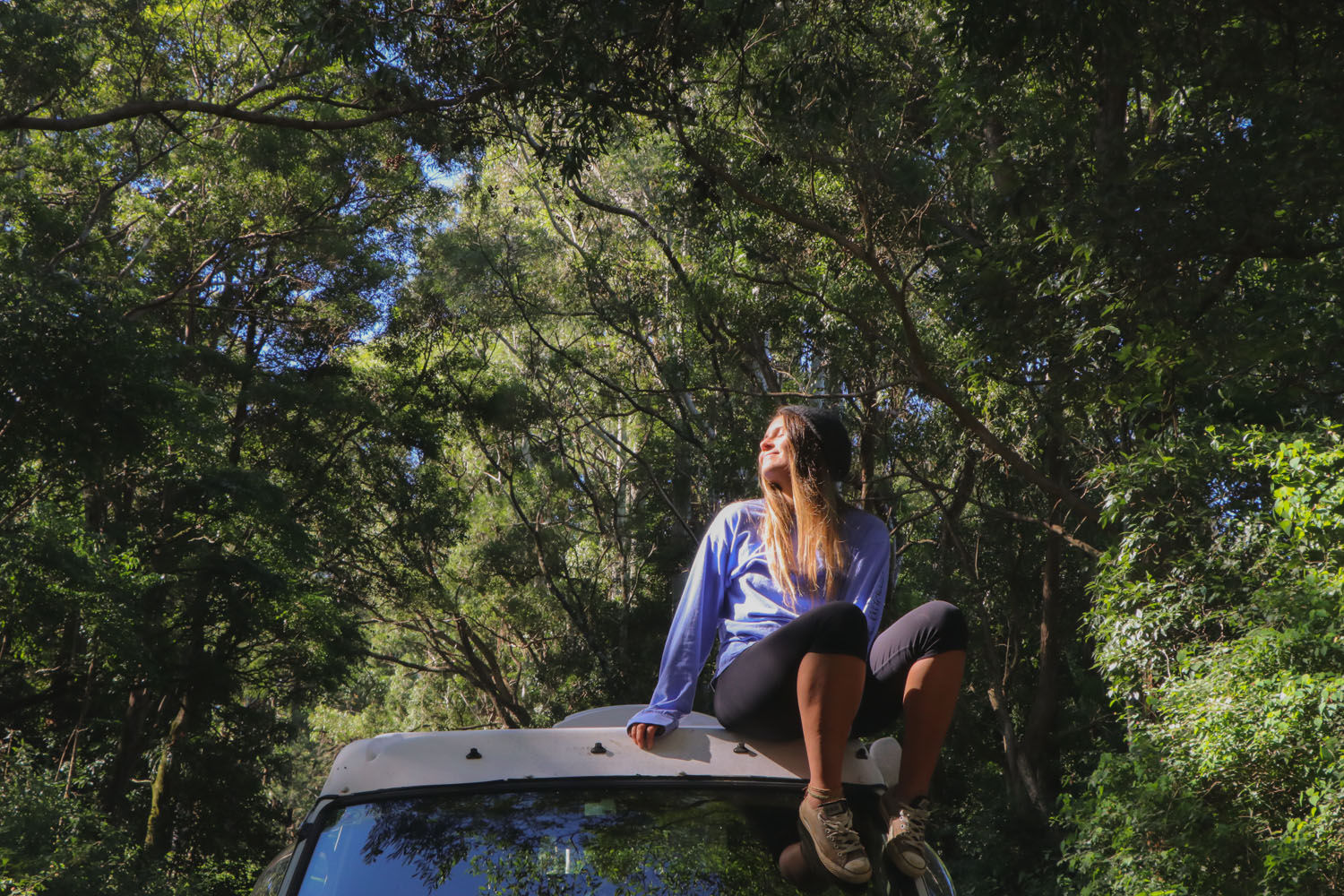
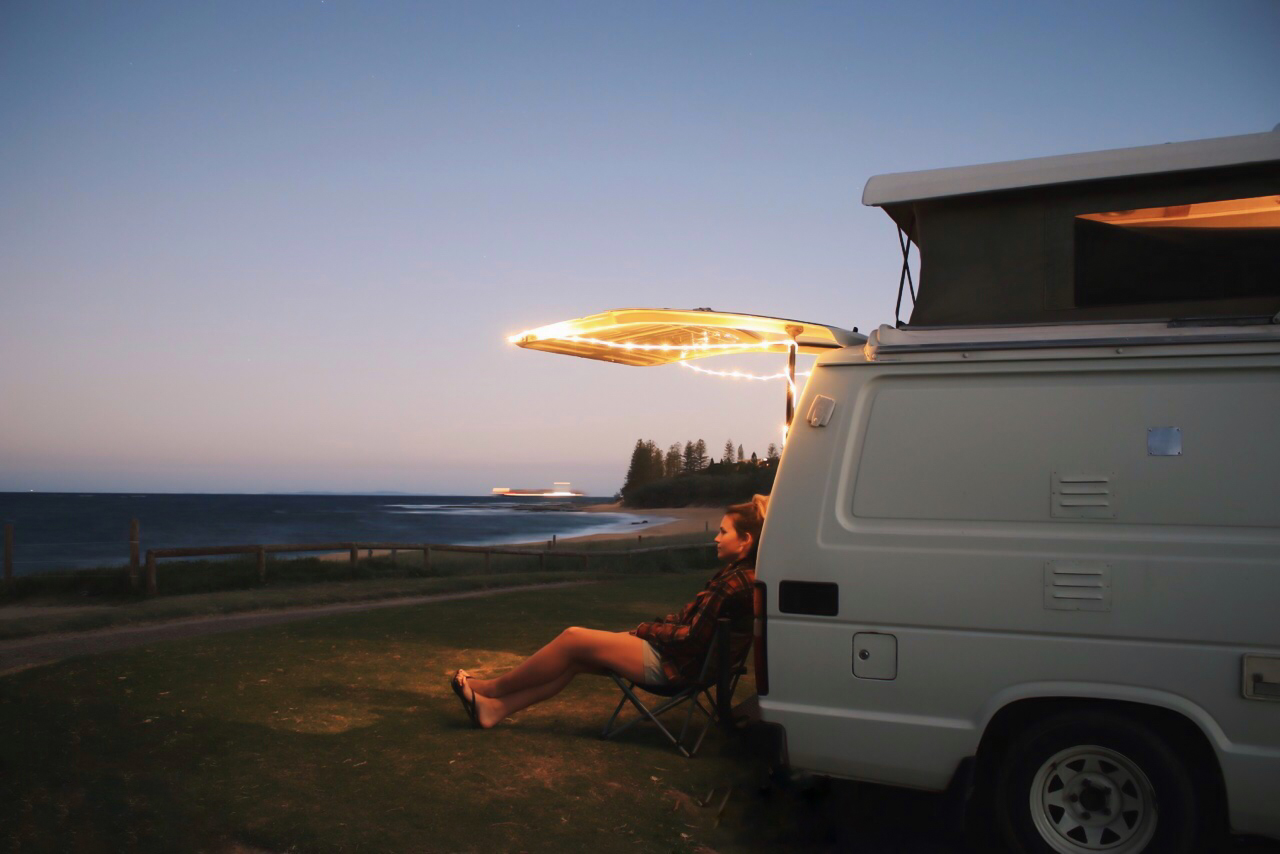
How did you choose a 1985 Toyota Hiace for your home wheels? Did you build out the van or customize it before you moved in?
We inspected a handful of different pre-owned vans that were already fitted out as campers. They were all older, and small. We were 21 and 22 with no savings and had our price filter set at maximum $9k when searching online! The idea of doing our own interior didn’t even cross our minds at that point – probably because we’d never done anything like it so didn’t see it as an option.
The reason we chose the old Toyota Hiace with a pop-top was because we wanted to be able to stand up in it, but still be discreet if necessary. We live on the coast so rust is a big issue with most older vehicles, but this one was clean. The interior was done well, and it was fine mechanically. It had a long wheel base, which meant that little bit more space. We lived in it that way for eighteen months, before we started to notice feelings of longing for more space. Features we used to love became clunky, and we began to imagine spaces built in different ways, and things we could improve on.
We moved back into a rental property to take a break, and decided we would demolish and rebuild everything. John did a lot of research and found everything we needed to know about flooring, carpentry and electrical work online – he did an amazing job for someone with no experience in any of those trades. We knew what we wanted, and exactly what we needed in such a small space, so were able to build ourselves a tiny home that perfectly suited our needs.
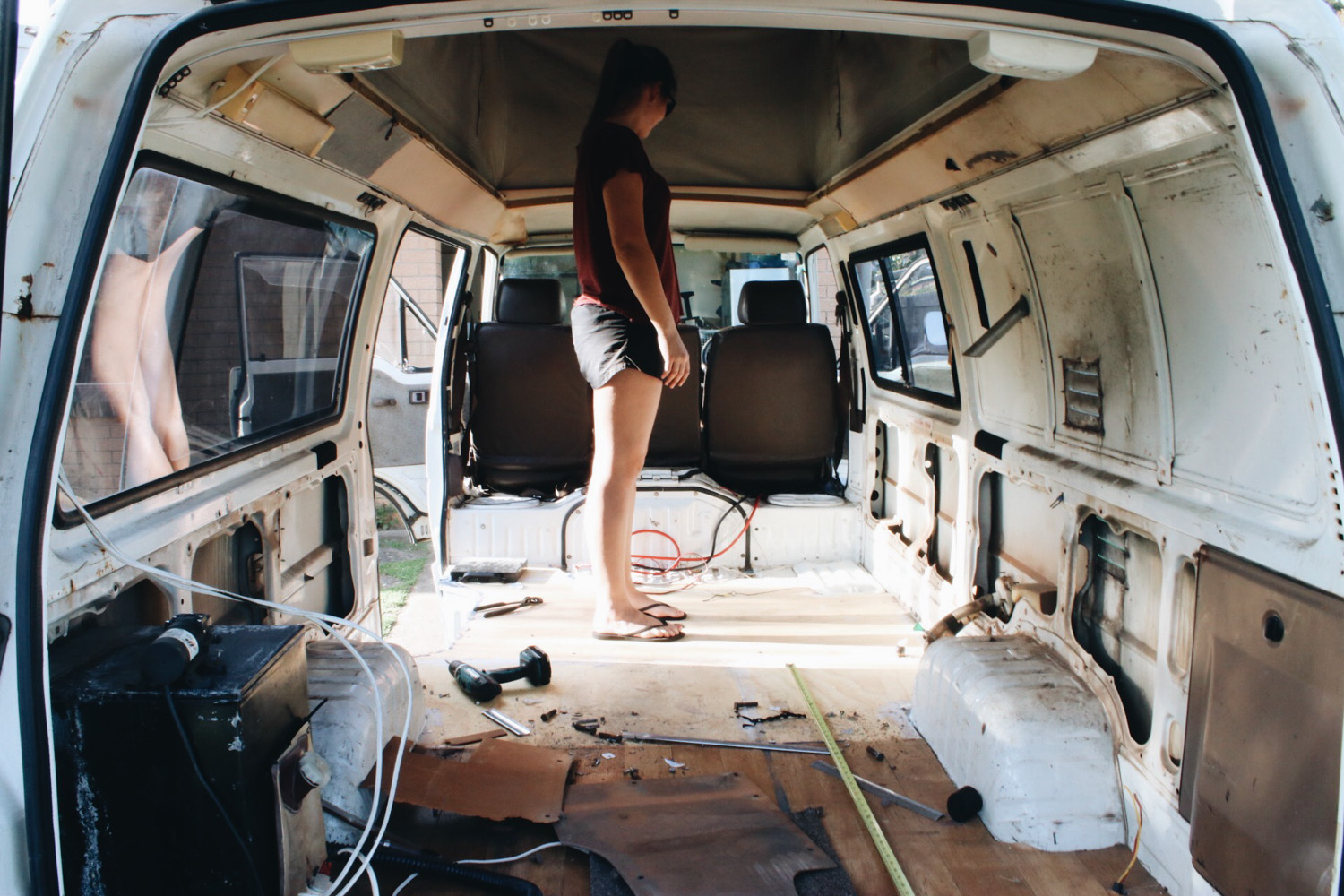
Jasmine inside the gutted van
Our interior is mostly timber, so it has a cabin vibe, but is still light and airy. Everything has a place, without being overly tidy or super clean. There’s dog hair and sand from the beach in most corners and cracks but we wouldn’t have it any other way.
Jasmine and John documented their whole build. Find more info, videos, and a van tour here!
You say you don’t plan on living in a house again in the foreseeable future and view your lifestyle as a long-term shift. Is there anything you miss about the life you left behind?
I have fleeting moments of longing for things like a real oven, or my old couch to sprawl out on in a big living room, but honestly they’re just that – fleeting.
Instead, I eat more fresh food in the van, or eat out if I miss baked/roasted foods that much. I sprawl out on the beach, or on a blanket under a big tree. Some daily tasks are a little harder to complete, but they’re just petty things, like washing dishes in a small sink versus a ‘normal’ sized sink, or having to put the top down when it starts to rain.
The positives outweigh the so-called negatives. My mentality has shifted greatly away from things like habit and convenience.
I try to focus on appreciation and gratitude for the cozy little home that we do have. To do laundry, we have to actually drive to a laundromat – but then our home is parked outside and we can still relax and watch Netflix while we wait. The positives outweigh the so-called negatives. My mentality has shifted greatly away from things like habit and convenience.
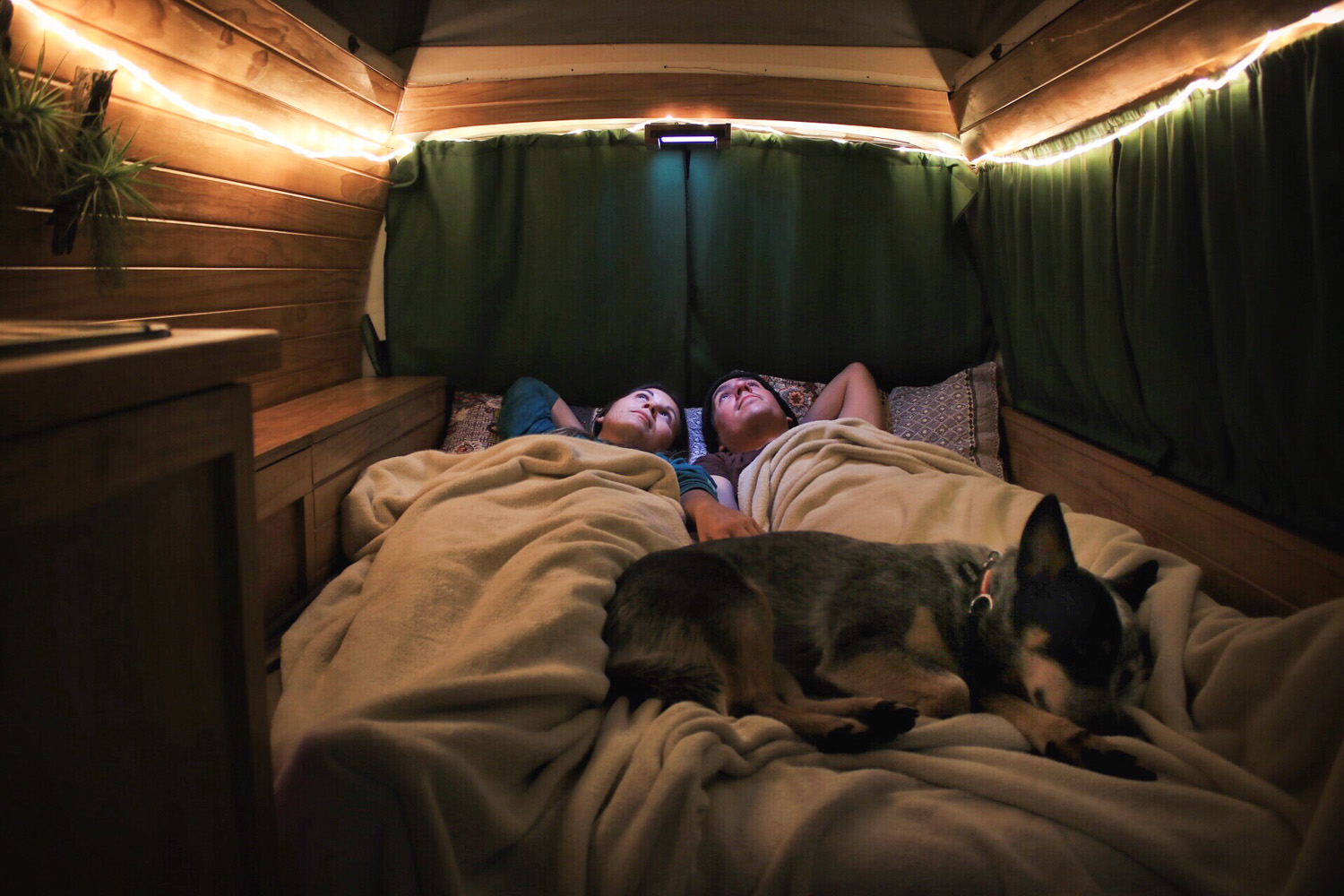
Cozy in their home on wheels
A big motivation behind your van dwelling lifestyle is minimalism and environmental consciousness. How does #vanlife fulfill those intentions?
Living in a small space means we can only have the things that we really need. It’s taught us a lot about our priorities and spending habits. I have a decent sized drawer full of clothes and still find myself only wearing half of them!
We have a solar panel that powers our three LED lights, fan, water pump, USB charger and the outlet that we can charge our cameras and laptop off. It’s a simple 12v setup and completely energy neutral. Our on-board water tank is 60L and we only have to refill every three days or so, whereas the average water consumption of an Australian person is estimated to sit around 340L per day.
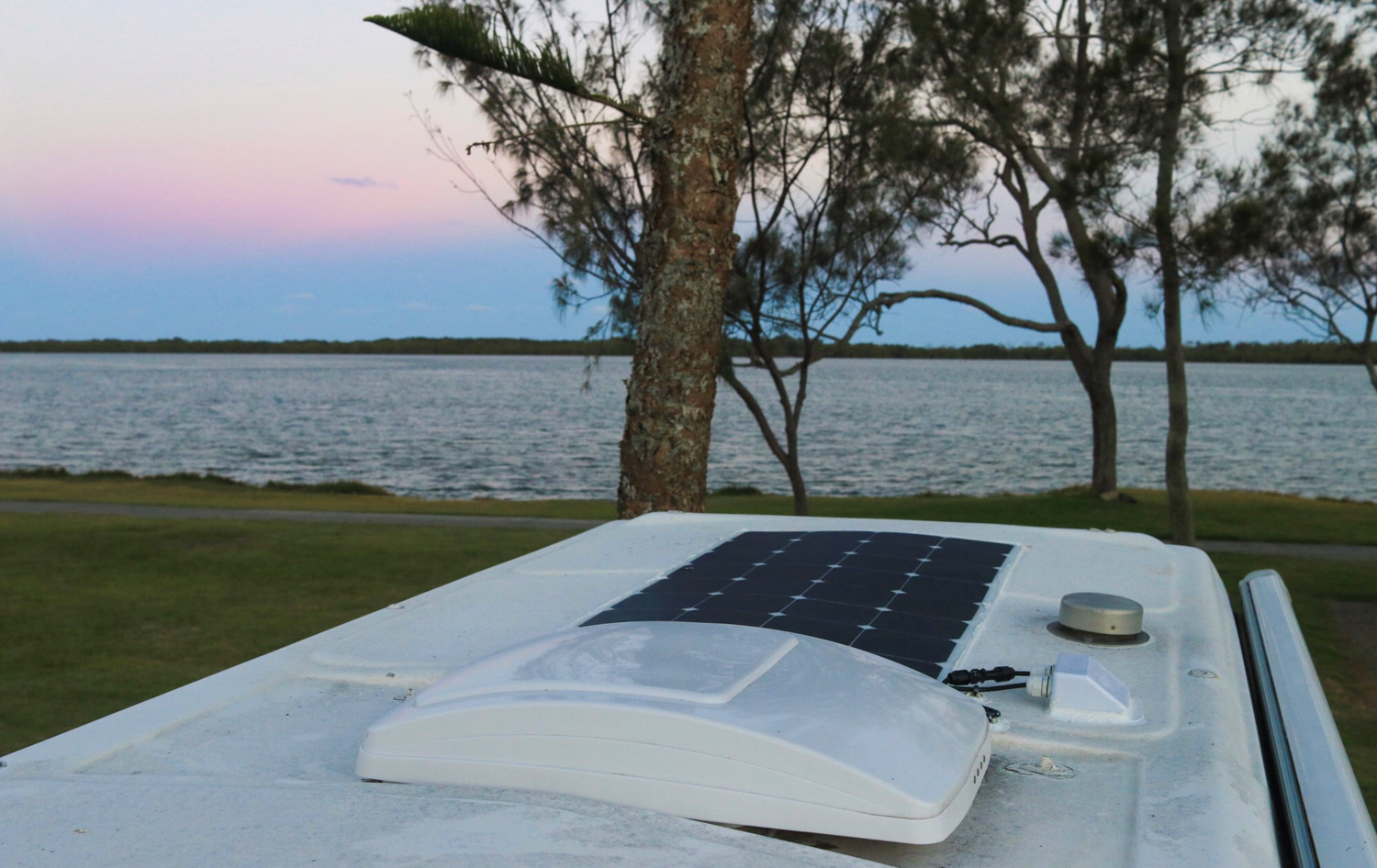
The van’s solar panel
Because we’re always outside, we feel an increased sense of connection to nature and the outdoors, and do our best to ensure our daily choices and habits reflect that obligation and connectivity.
At the end of the day, regardless of the specific numbers and facts, since moving into the van we’ve definitely become more conscious of our resource and energy consumption in general. We make our water last as long as possible, we monitor our energy usage via our solar charger to ensure we don’t ever come close to draining our battery, and are very careful with the amount and type of food that we buy. We don’t have a fridge, so take any leftovers to work with us for lunch or to store overnight, and avoid wasting food at all costs.
Because we’re always outside, we feel an increased sense of connection to nature and the outdoors, and do our best to ensure our daily choices and habits reflect that obligation and connectivity.

Tell us more about Plastic Free July and the war on waste.
I first heard about the Plastic Free July movement when I attended a local screening of a documentary about plastic pollution, A Plastic Ocean. My local Aquarium hosted the event and provided information afterwards about ways people can get involved with reducing waste – participating in Plastic Free July was one of them. A friend and I agreed to take on the challenge and we both gave up single use plastic for the entire month – it was a huge eye opener.
I prepared by shopping for grains, oats, beans, rice etc at my local bulk goods store, where you can either fill brown paper bags or your own containers from home. I didn’t buy any produce that was packaged in plastic, and opted to buy loose items instead or shop at the market. I gave up many of my favourite foods simply because they came in plastic packaging. It has really made me consider my choices and think a bit more about what I should be purchasing and supporting.
Around the same time, a series was airing on national television called War on Waste. It provided insight on food waste and plastic waste in Australia, as well as the impacts of fast fashion and issues with our recycling system. Although we have a long way to go as a country, I’m really happy to see the efforts being made, particularly this year, by individuals and organizations. From companies that recycle soft plastics into street furniture, to a band of cafes that give discounts to customers who bring their own cup – there is hope that we are headed in the right direction.
Can you share a few tips for others who want to be more minimalistic and eco-friendly?
One of the easiest things that anyone can do is to have a kit of re-usable items with you in your car or at your workplace – wherever you spend most of your time outside of your home. It can be as simple as a cotton shopping bag with a reusable coffee cup, water bottle, tupperware container, metal straw, some cutlery and a few produce bags.
It can be overwhelming to analyse your daily life and realise the impact your choices have. Rather than panicking or getting upset, I encourage people to start small and change one thing at a time.
This means that every time you eat out, or visit the grocery store, you can avoid as many single-use plastic items as possible. You can still grab a coffee or juice on the run, pick up some take-out for lunch on a work day, or make an unexpected trip to get some groceries – and also be waste free. More and more businesses are supporting the re-usable movement and even offering discounts for customers who bring their own containers and cups. This is a great initiative as a huge portion of the world’s plastic pollution comes from food and beverage packaging.
It can be overwhelming to analyze your daily life and realize the impact your choices have. Rather than panicking or getting upset, I encourage people to start small and change one thing at a time. There are so many green alternatives to mainstream brands of beauty products, cleaning products, and foods, and they are widely available in most supermarkets. Try organic shampoos and soaps instead of chemical based ones, bamboo toothbrushes instead of plastic, plant-based cleaners over harsh chemicals, and non-dairy milks instead of commercial dairy milk. Every little purchase is a vote for what you believe in.
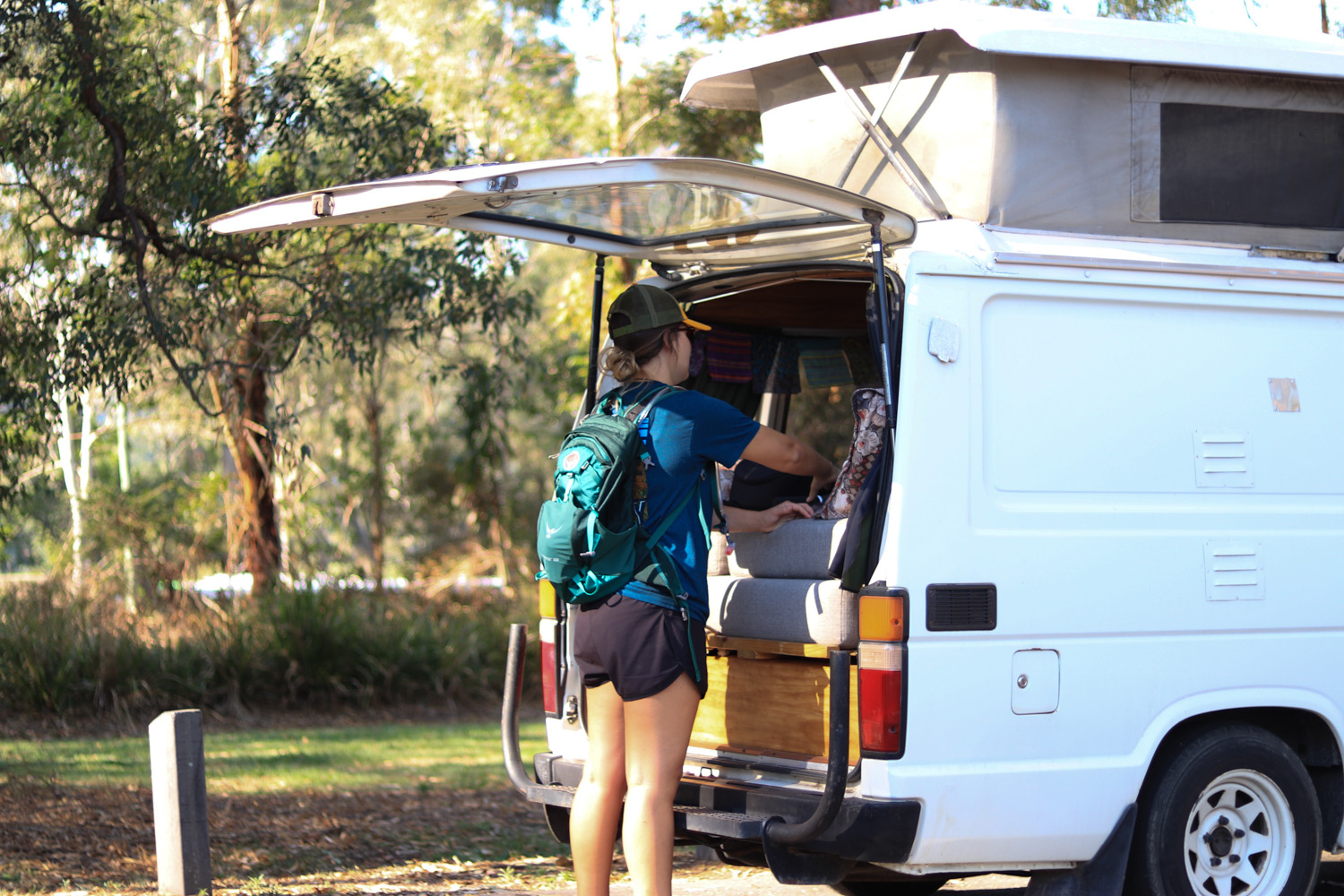
You and your husband, John, both work 4-5 days a week and don’t travel around as often other van-dwellers seem to. Tell us about your work and why that keeps your roots planted.
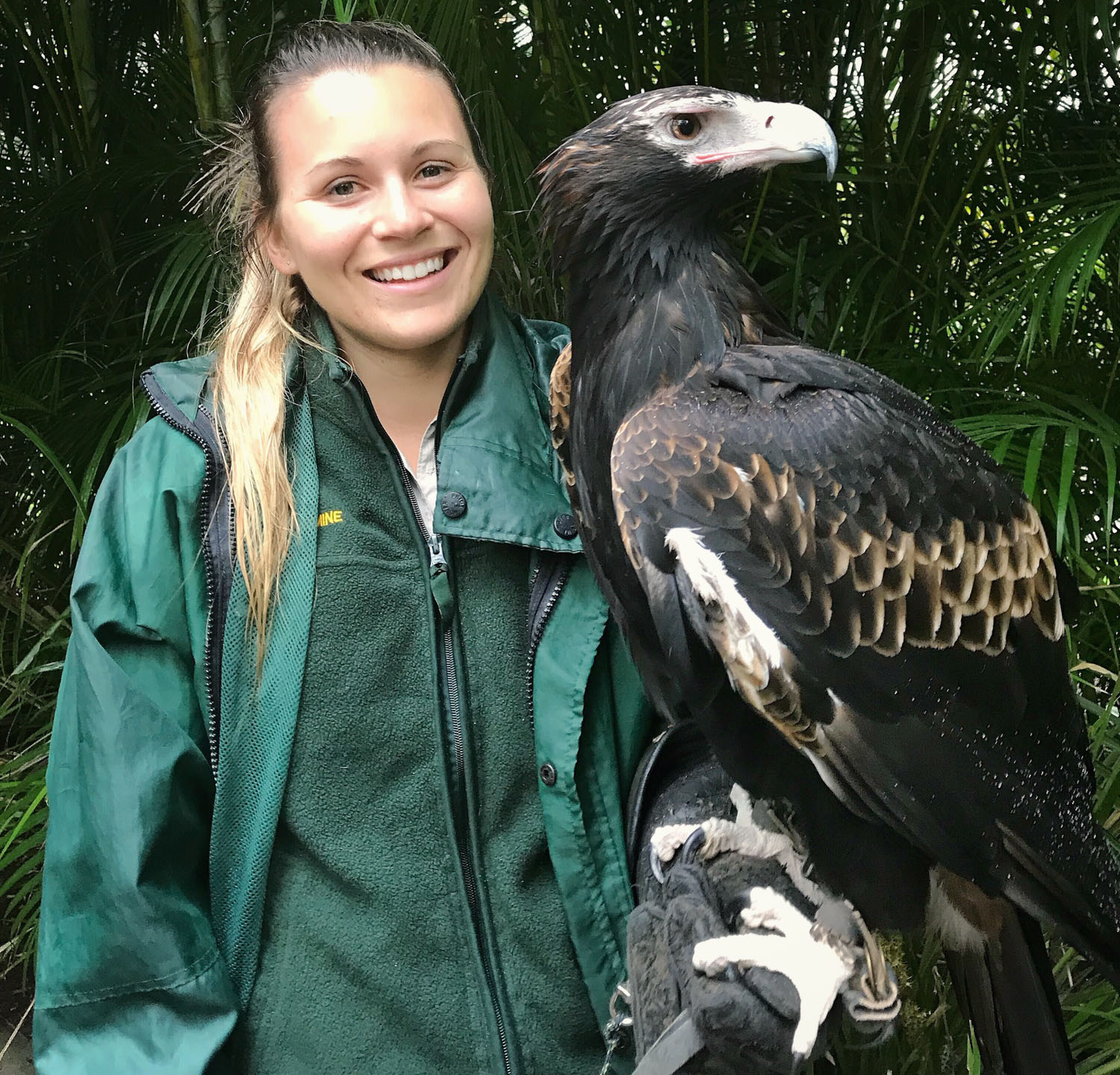
Jasmine at work
I’ve been at my current job for the past four years and absolutely love it. I work with birds at a zoological facility here in Queensland, Australia – teaching the public about how to protect and conserve them, presenting exciting and informative demonstrations with them, and of course feeding and cleaning up after them. Working with animals, no matter what country you live in, will definitely not make you a millionaire – it’s hard work, and definitely a labour of love. But I feel really lucky to have a job that is still challenging, stimulating and rewarding, and that brings me such joy.
John has worked in the pet industry for the past six years and was lucky enough to transfer within his company to the area we live in now when I first got my job here. Our dog River goes to work with him most days and has since she was a pup – it’s an awesome arrangement that we definitely don’t take for granted, and she loves it too.
What’s your next overseas trip? What are you looking forward to seeing/doing/feeling there?
We’re a little undecided, but would really love to explore India in 2018. We haven’t yet travelled anywhere in Asia and are drawn to the culture, food and history of southern Asia. But we’re also really keen to explore South America. We backpacked all through Central America a few years ago and I fell in love with the language, climate and wildlife and can’t stop fantasizing about returning. Really, we just want to go everywhere!
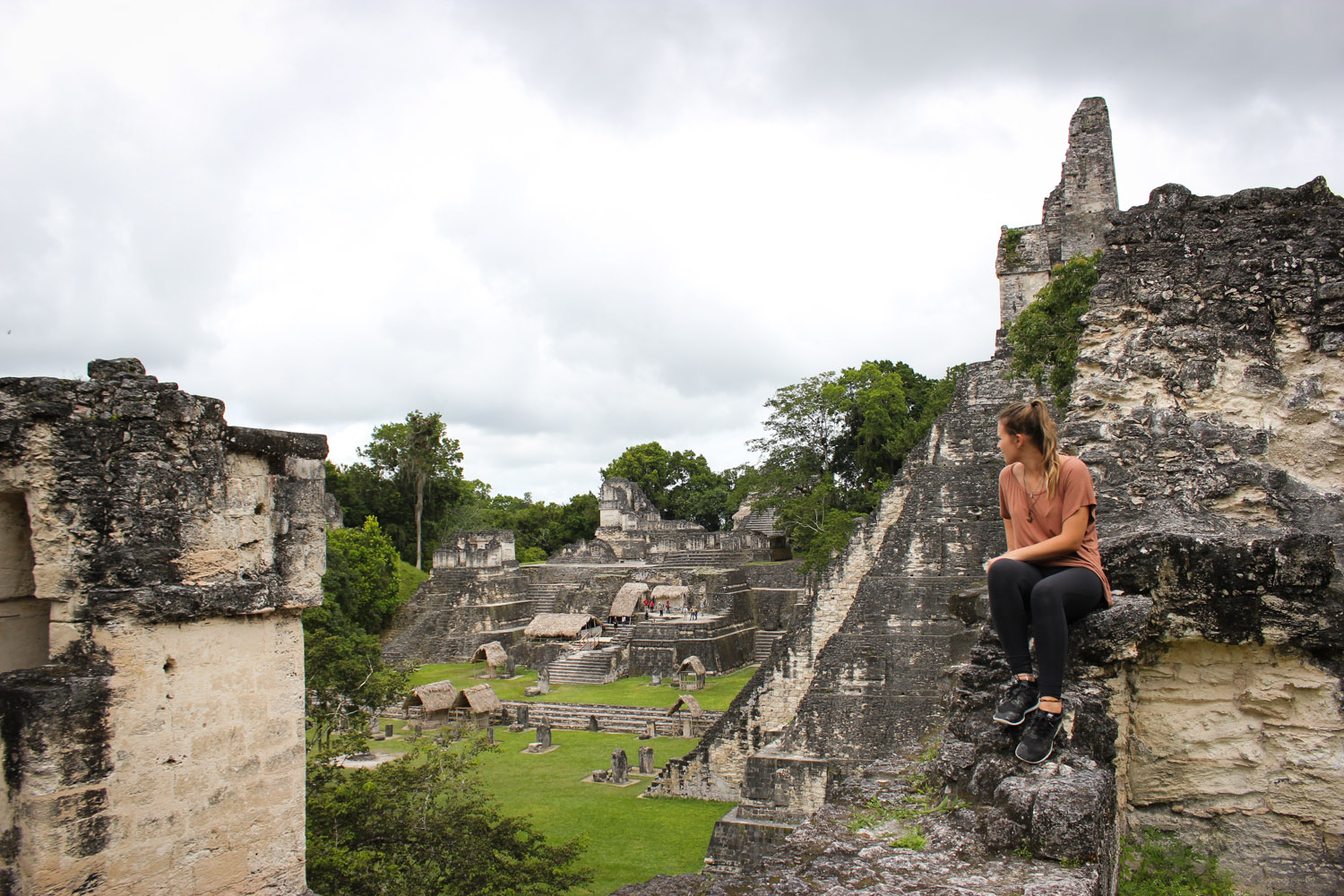
Tikal National Park, Guatemala
What are your 5 must-have items for van life?
- Solar panel – to charge our phones,cameras, and laptop
- A Hydroflask- to have cold water no matter how long the van sits in the Australian sun
- Our guitar – to play our favorite songs and slow down every now and then
- Our dog – to remind us to get outside more often, and to find joy in the little things
- A sense of humor – because things don’t always turn out as planned and there’s nothing to gain from dwelling on the little inconveniences and roadblocks that sometimes come with life on the road
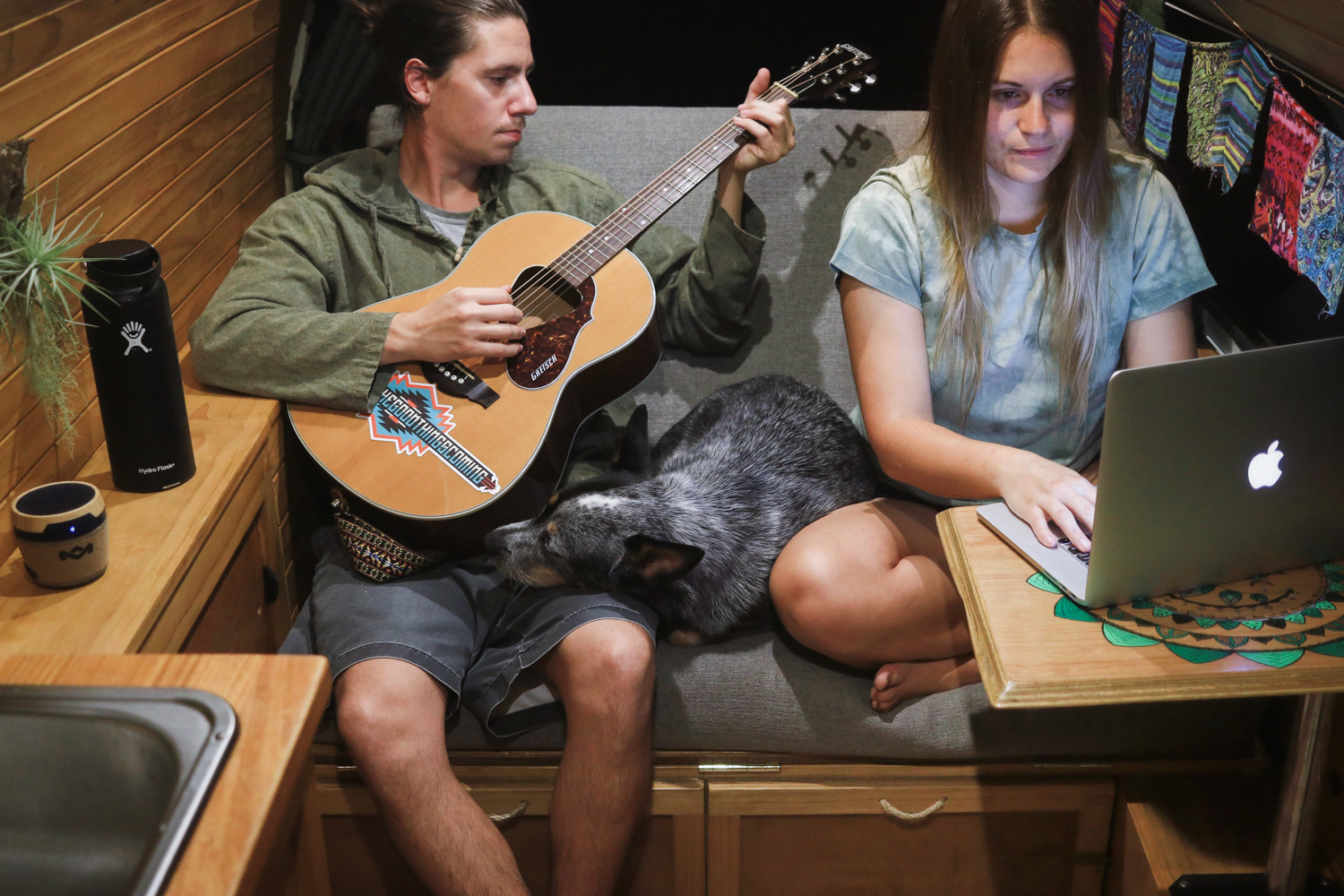
If you’ve ever been profoundly changed by a landscape or experience, which one, and why?
In late 2014 John and I visited Tikal National Park, which is an ancient Mayan ruin site in rural Guatemala. We stayed overnight and started hiking around 3:30am to get to the tallest pyramid in the park and watch the sunrise.
As we sat there in the dark waiting, the jungle slowly started to come alive with the calls of Howler Monkeys. First one, then a few more, then before we knew it their deafening roars were echoing throughout the canopy all around us. It was absolutely bone tingling.
We sat there stunned and speechless at the sheer wildness and history of the place. I felt so small and insignificant in that moment, and still get choked up when I think back to how special and humbling it was.
See more from Jasmine on Instagram. Follow the Cabin Camper adventures on Instagram and at thecabincamper.com.
Do you dream of taking your life on the road?
Be the first to comment